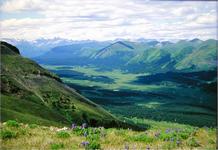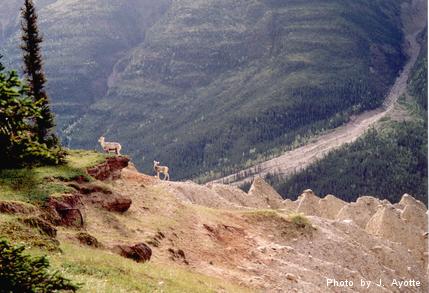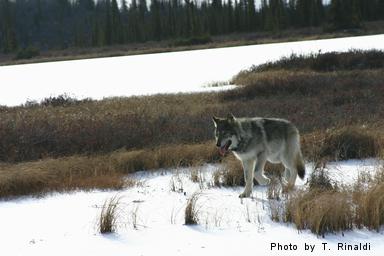I am interested in the factors that constrain
wildlife species and the flexibility in strategies that animals use to
survive them. My current focus is on trade-off decisions related to body
condition, reproduction, and predation risk for ungulates in Arctic and
boreal systems.
Influence of Prescribed Fire on Focal
Ungulates
|
|
The diversity and abundance of large
mammals in the Muskwa-Kechika Management Area of
northern BC occur because of extensive habitat
heterogeneity, due largely to topographic diversity, but
also because of fire as a disturbance agent.
Prescribed fires are a part of current land
management actions to enhance ungulate populations.
Few studies though have sought to understand what
the contribution of prescribed burns is to maintaining a
globally recognized system, and whether the stability of
the system as we know it is being altered by burns
because of species interactions and changes to species
assemblages.
We are concentrating on two focal species, elk
and Stone's sheep, which both select for the
high-quality vegetation resulting from burns.
Our goal is to understand the extent to which one
species is being displaced or competes with the other,
potentially altering system dynamics.
We will quantify both animal and plant response
by monitoring seasonal movements of radio-collared
animals in relation to burned areas; determining how the
size, age, and vegetative quality of burns influence the
use of burns; and identifying seasonal range overlap and
interactions in the use of burned areas.
|
|
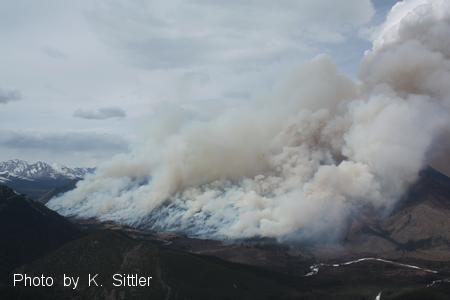
|
Habitat Segregation in Boreal Moose Populations
|
|
Moose are a focal species in most boreal systems of
Yukon. To provide meaningful input into land-use
planning and impact assessment processes, the objective
of this study is to quantify seasonal habitat selection
and movement patterns of different moose cohorts
(females with and without calves, males). We will
quantify mechanisms behind habitat segregation, in terms
of risk (human harvest and predation by wolves) and
forage resources, which might drive different ecological
patterns and identify limiting or critical habitats.
Information obtained using GPS collars will be interpreted within the context
of traditional knowledge provided by Teslin Tlingit
Council.
Collaborator: Rick Ward (Yukon Department of
Environment)
|
|
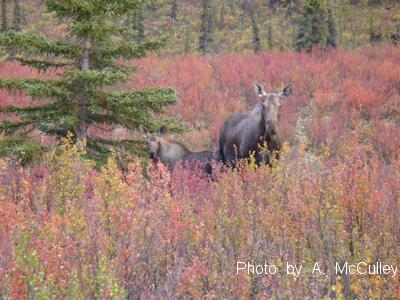
|
Habitat Influences on Woodland Caribou
|
|
Woodland caribou are now designated as a species-at-risk
nationally by the Committee on the Status of Endangered
Wildlife in Canada (COSEWIC) under the Federal Species
at Risk Act. Threats to caribou increasingly
involve changes in the quality and availability of
habitat. Our goal is to define the nutritional
influence of habitat on caribou and to provide a
quantitative basis to describe how habitat changes
contribute to future populations. We propose three
phases to the work. Phase I includes captive
caribou experiments at the University of Alaska
Fairbanks to quantify the effects of nutrition on
maternal body condition, calf birth mass, lactation,
calf growth, breeding dynamics, and carry-over effects
across seasons. Phase II consists of foraging studies
with tame caribou in natural plant communities at
several regional sites across Canada. We will
quantify the nutrition levels that caribou can actually
acquire from different plant communities and relate the
findings to habitats used by free-ranging caribou.
Phase III
will bring together the research findings from the first
two phases to forecast the contributions of habitat to
population dynamics, and to explore the implications of
changes in climate, ecosystems, and disturbance.
Collaborators: Perry Barboza (University of Alaska
Fairbanks), John Cook and Rachel Cook (National Council
for Air and Stream Improvement; NCASI)
|
|
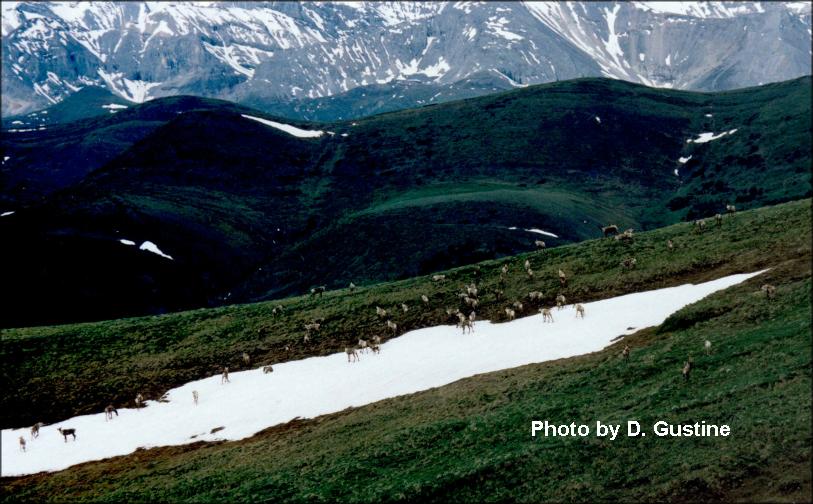
|
Protein Dynamics in Caribou
|
|
In collaboration with Dr. Perry Barboza at the
University of Alaska Fairbanks, the objective of this
research has been to define relationships among body
condition (as indexed by body protein) of gestating
caribou, their low-protein lichen food resource, and the
allocation of maternal body protein versus dietary
protein to fetal growth. Following captive animal
studies, we are now using isotopic indices of body
protein in free-ranging caribou herds to better
understand the dynamics of caribou / lichen ecosystems
as they relate to reproduction. This information
contributes to the CircumArctic Rangifer Monitoring and
Assessment (CARMA) network for which the goal is to
monitor and assess the impacts of global change on
human/Rangifer systems across the Arctic.
|
|
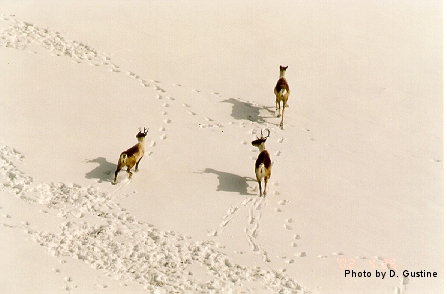
|
Muskwa-Kechika Predator-Prey Dynamics
|
|
This research is a large-scale effort
to understand the dynamics of the large mammal
predator-prey systems in the Muskwa-Kechika Management
Area of northern British Columbia. The overall
goal has been to quantify the ecological web of
interactions among the focal mammal species by defining
processes, core areas, typical movements and specific
habitat requirements for large ungulates and large
carnivores that use large portions of a large landscape.
We combine field-based research, GPS technology, satellite imagery, and GIS to quantify these interactions.
Resulting information will inform land-management
decisions and conservation area designs so that future
impacts to wildlife and wilderness values in this region
are minimized. The research has entailed
coordinated linkages among several different projects
and findings are being incorporated in other studies
(e.g., Influence of Prescribed Fire on Focal Ungulates,
Habitat Segregation in Boreal Moose Populations).
Collaborators: Mike Gillingham and Roger Wheate
(University of Northern British Columbia), Doug
Heard (BC Ministry of Environment).
|
|

|
| |
Plasticity in selection strategies
of woodland caribou
Woodland caribou are the best year-round landscape-level
indicator species in the study area. Two primary objectives were
to define seasonal selection strategies for core wintering areas
and calving grounds, and to determine which calving strategies
are most successful for neonatal survival.
|
| |
Seasonal habitat selection and
behavioural strategies of Stone's sheep
Stone's sheep are probably the ungulate species that is
most susceptible to disturbance in this system. An overall
objective was to improve habitat models for sheep by
specifically defining habitat requirements based on vegetation
communities, topography, and risk of predation. We also
quantified intrasexual habitat selection relative to maternal
status, and defined seasonal variation in naturally-occurring
concentrations of glucocorticoids for Stone's sheep.
|
| |
Defining the predator landscape of
grizzly bears and wolves
Large predators influence the abundance and
distribution of ungulate communities. Our primary objectives
were to define resource selection by grizzly bears and wolves in
relation to prey, to determine what the prey of choice is, and
to determine when prey switching occurs. We identified important
habitats and core areas of concentration and assessed whether
current habitat models, which are typically based on vegetation
communities, were appropriate for defining habitat value for
predators.
|
|
The role of
moose and elk in a multi-prey multi-predator system
These two large-biomass species in the system play
important roles in structuring the large predator community.
Objectives were to analyze movements and habitat selection by
moose and elk in relation to less predictable or attainable
ungulate prey species (caribou and Stone's sheep) and relative
to predator selection strategies.
|
| |
Use of licks by large ungulates
Licks are site-specific habitat features that are
important to maintaining health of some ungulate populations.
The use of licks can be an indicator of physiological needs in
animals that are unable to meet nutritional demands with forage
alone. We determined the chemical properties of licks,
differences between wet and dry licks, and the timing and
frequency of use by Stone's sheep, mountain goats, moose, and
elk. This information contributes to our knowledge of ecosystem
function and helps build an information database for the timing
of use of critical habitat features. |
